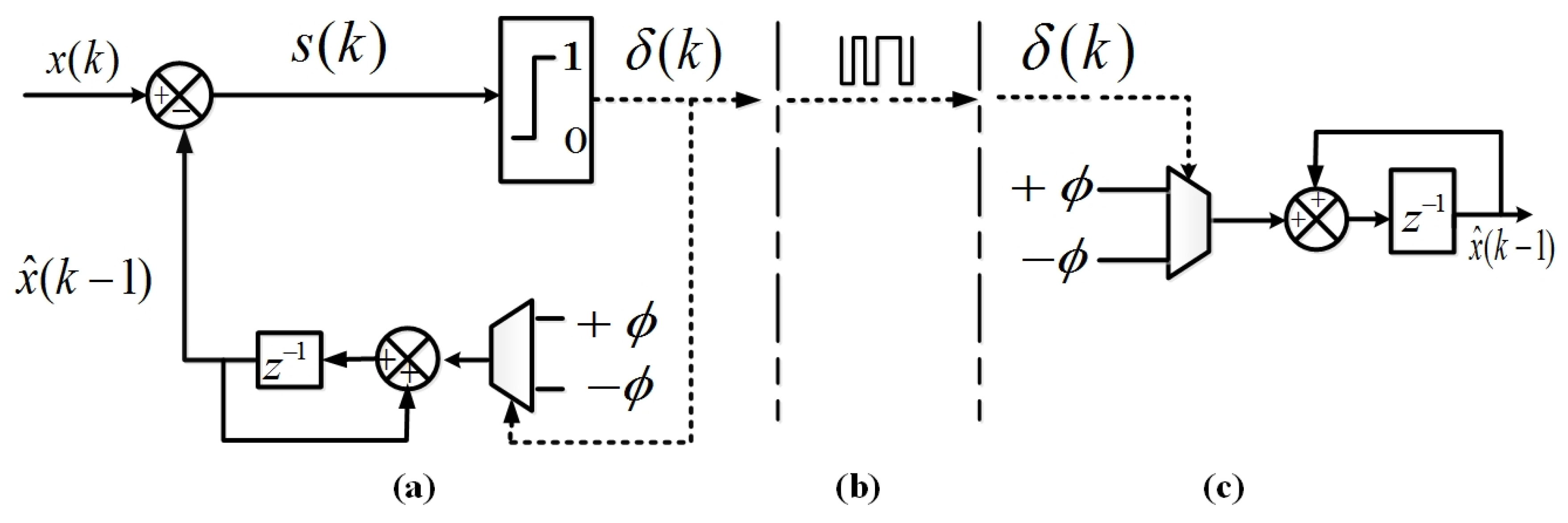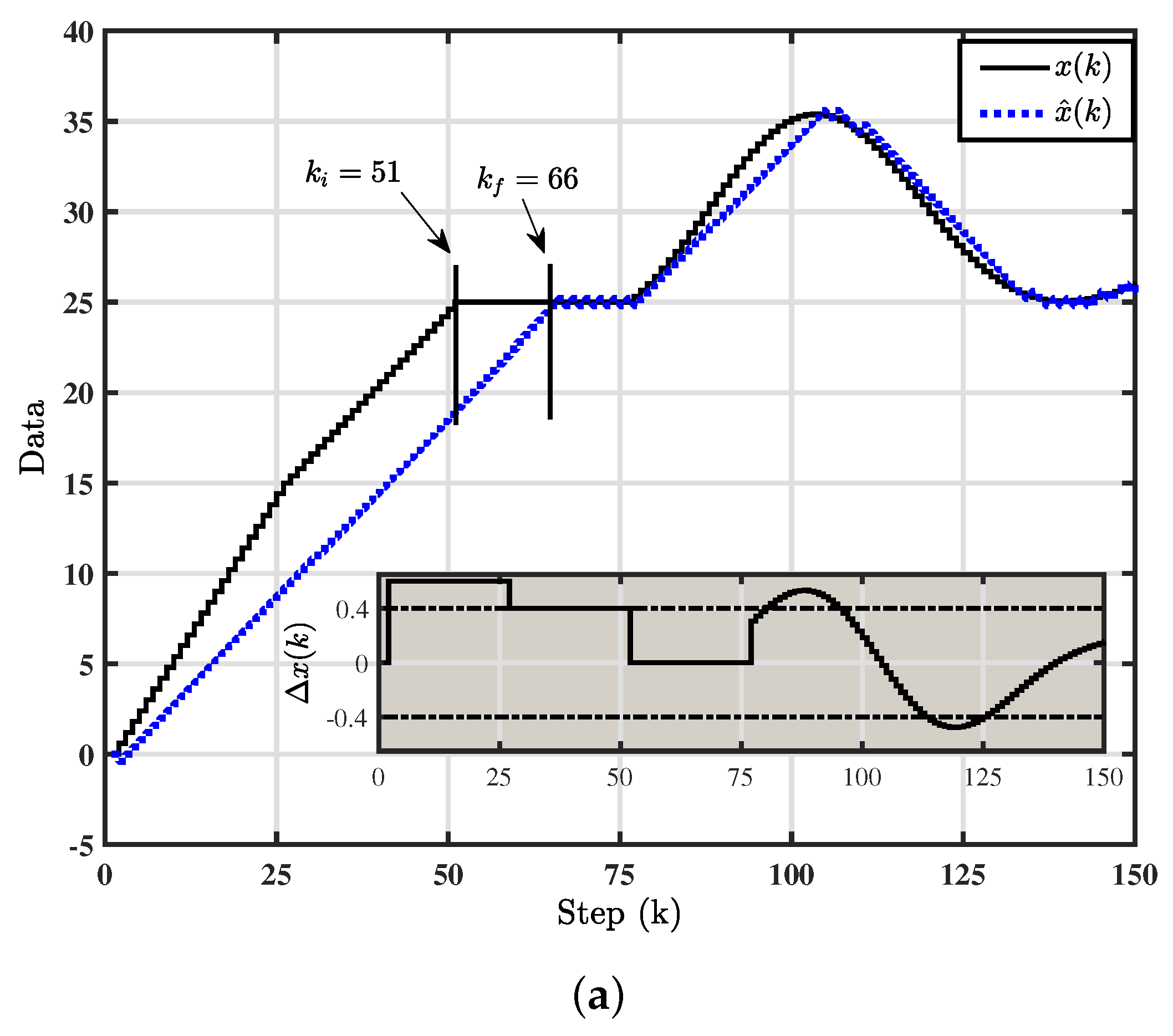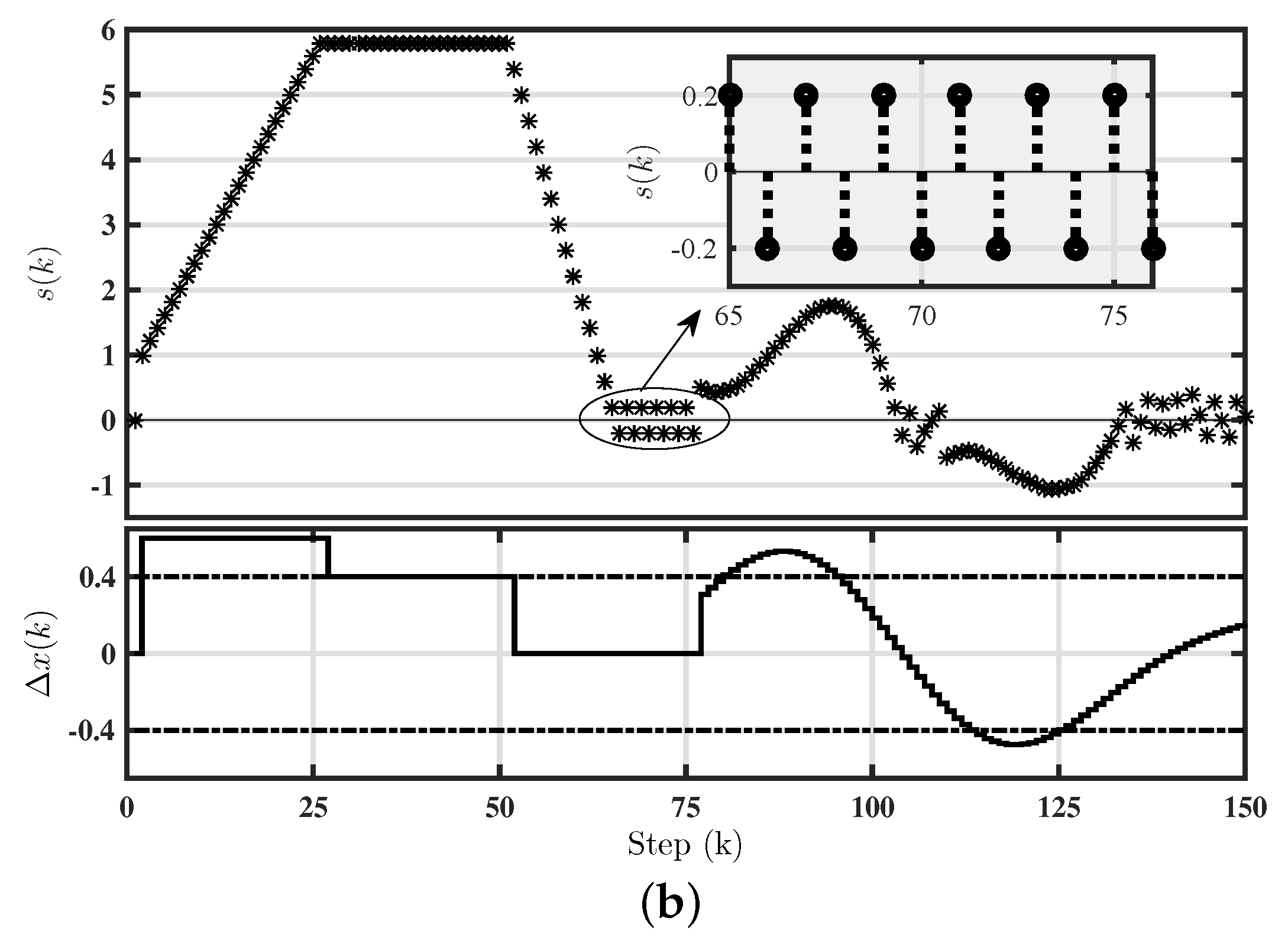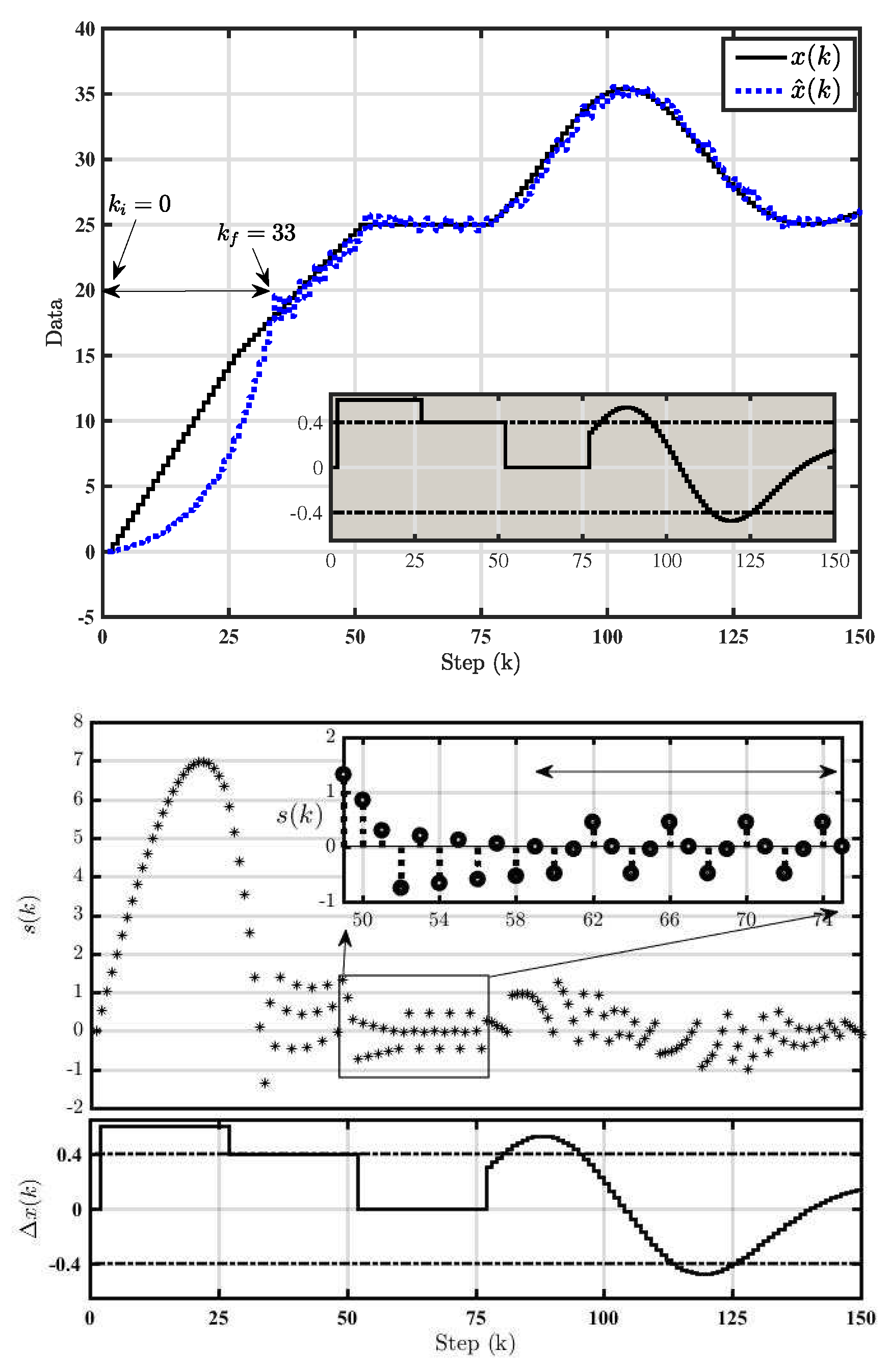1. Introduction
Over the last few years, the quantizers and modulators have gain popularity due to their important role in many engineering fields including measurement, instrumentation, power converters and analog to digital conversion (ADC) [
1,
2]. In particular, the binary quantizers including delta modulators (
-Ms) and delta sigma modulators (
-Ms) are widely utilized in power conversions for their implementation simplicity [
3,
4], networked and quantized control systems for their low-data rate [
5,
6], and as typical complex systems for their high nonlinearity, periodicity and robustness at the same time [
7,
8]. Such systems are often used as coding mechanism in many applications such bio-medical engineering (see [
9,
10]) due to their low energy consumption and ability in data compression and for reducing the wiring in communication systems where the communication channels are shared by many entities and hardware resources are limited [
11,
12].
In practical engineering applications, the
-M is often implemented either in continuous or discrete-time domain. However, it is important to point out that the selection of the domains, discrete-time (DT)
-M and its continuous counterpart, the continuous-time (CT)
-M, is often subject to the nature of the interconnection of components and devices in the applications [
12]. For instance, using CT
-M is fitting in continuous-time systems where the input/output signals are continuous-time. Similarly, in discrete-time systems where the input/output signals are discrete-time, it is proper to utilize DT
-M. Further, in some hybrid applications, the
-M can be implemented either in analog or digital integrated circuit frameworks depending on the availability of the hardware resources and the technical expertise of the designer.
A typical structure of of both
-M and
-M consist of a transmitter (encoder) connected to a receiver (decoder) through a binary communication channel. The systems are often classified as dynamic quantizers [
12]. As other quantizers, they contain coarsest quantizers (relay components) where high nonlinearity and complex behavior are inherently exhibited [
12,
13]. Despite the fact that both systems have many resemblances, each one of them has some different features which differentiate them. For example, the output of the transmitter is a binary signal that represents the derivative of the input signal of
-M. Thus,
-M is also referred to as differential modulator and the demodulation at the receiver side is preceded by an integrator to reconstruct the input signals [
14]. However, the output of the transmitter of
-M is an over-sampled binary signal that contains the dynamic ranges of the low-frequency part of the input signal (so-called noise shaping feature) [
15]. To reduce the quanitization errors inserted by
-M and
-M systems, the output signals should be processed with decimation filters to generate the quantized counterpart of the input signals. In particular, the conventional
-M can roughly be classified as a two-level dynamic quanitizer with fixed step-size (alternately referred here to as fixed
-M) whereas
-M with adaptive quantizer step-size is alternately referred to as adaptive
-M [
14]. It is essential to mention that the selection of the gains plays a critical role in the performance and the stability of
-M [
16,
17]. Thus, to alleviate the demerits associated with the standard
-M, the adaptive
-M attempts to increase the dynamic range of the dynamic range and stability region of the fixed
-M [
18,
19,
20].
In the literature on
-M, some works analyzed the dynamical behavior of the fixed
-M in terms of stability and periodicity. For example, the stability analysis and periodicity of self excited and fixed
-M is carried out using sliding mode theory in [
6,
7,
8,
16,
21], which is often used for the analysis of such chaotic systems with complex behaviors [
22,
23]. In [
24], authors briefly studied the stability of data-driven
-M, where the equivalent control-based sliding mode is applied to investigate the stability analysis and the dynamical behavior of the fixed
-M. However, it is remarked that the dynamical behavior and stability analysis for the adaptive
-M have not been reported in the literature.
Motivated by the above discussion, the presented work investigates inherent dynamical characterizations of data-driven fixed -M and adaptive -M in DT domains. We state the stability conditions, define the periodicity and accurately approximate the reaching time (so-called hitting-step) for both the DT fixed and adaptive -Ms using sliding mode theory. The appropriate quantizer gainfor the fixed -Mis determined using the dynamics of the input signals. With appropriate choices of quantizer gain and parameters of the fixed and adaptive -M, we show that both fixed and adaptive -Mconverge to periodic-2 and periodic-4 orbit in the steady-state, respectively. The analytically established findings in this paper are validated via numerical simulations.
The organization of this paper is thus. In
Section 2, we discuss the dynamic properties of the fixed
-M in DT domain with more focusing on the periodicity. Then, we study the stability and periodicity of the adaptive
-M in DT domain in
Section 3. The simulations of both are presented in
Section 4. Finally, we conclude and summarize our results in
Section 5.
2. Fixed Delta Modulator (Fixed -M)
Before proceeding to study the dynamical characterizations of both the fixed and adaptive -Ms, it is of the essence to define the quasi-sliding mode and reaching condition.
Definition 1 ([
24]). The DT sliding mode trajectory
is described by so-called quasi-sliding mode in the vicinity
if
holds for
, in which
is a positive integer. The domain for the motion of
is known as the quasi-sliding mode-domain (QSMD). The
, which bounds the motion of the trajectory
, is known as the quasi-sliding mode-band (QSMB). Moreover, the quasi-sliding mode satisfies the reaching condition for any
if
in which
represents the reaching steps.
As per the definition of quasi-sliding mode, there are two possible cases for the motion of ,
If the trajectory satisfies the reaching conditions (1.a) and (1.b), then it will clearly move from case 1 to case 2, ultimately. The motion of the trajectory in case 1 is called reaching phase and the steps are also called reaching steps (). In this work, the final step in case 1 is denoted by as ().
The dynamics of the fixed
-M depicted in
Figure 1 are described by the following equations
where
in which
if
and
if
. The binary communication channel, which exists between the transmitter (encoder) and the receiver (decoder) carries 1-bit signal defined as:
The notation of the transmitted binary code
is denoted by
whereas sgn function that ranges
is dented by
(i.e.,
). The transmitted binary code with sgn function such that
when
and
when
.
Lemma 1. Consider (2),
it follows thatwhere .
Proof. Substituting (
2b) into (
2a) gives
It follows from (2) and (
4) that
□
Stability, Periodicity and Estimation of the Hitting-Step for Fixed -M
The following theorem is devoted to derive the stability conditions of the fixed -M.
Theorem 1. Recall the switching function in (
3).
Ifwhere and , then the following holds: The system trajectory satisfies the reaching conditions of QSM (1) where QSMD is bounded by where .
The sliding mode state
requires at most
steps to cross the switching manifold
, where
(the notation
denotes the floor operation) and
For the special case of an input signal which does not change over time i.e., , the trajectory of (2) converges to a symmetric periodic-2 orbit.
Proof. The proof of the first point of Theorem 1 is divided into two cases (Case-1 and 2) depending on whether
or
. For case-1, where
, it follows that
. If (
5) holds, then
, where
. Following similar lines, for case-2, where
, this leads to
.
The proof of the second point of Theorem 1 can be also divided into two cases as before i.e., when
and
. Let us consider case-1 where
. The mth iteration of (
3) is expressed by
From the first point of Theorem 1, there exists a
step where
. Let us assume the maximum
m such that
, and
in (
7). It can be seen that the inequality (
7) implies
The same results can be found when
which concludes the proof of the second point Theorem 1.
For a special case of input signal which does not change over time i.e.,
, the switching function in (
3) becomes
From the first point of Theorem 1, the QSMD becomes
(i.e., the global attractor on
. Let
denotes the first step after
crosses switching manifold such that
. Next, we will study two possible cases that will take place for the sliding state
inside QSMD, i.e.,
and
. When
, it follows that
Similarly, when
it can easily be shown that
. It should be pointed out that once the sliding state
becomes inside the QSMD defined by
, it will also converge to the periodic-2 orbit. □
3. Adaptive Delta Modulator
The fixed -M is replaced by its adaptive form, i.e., adaptive -M, to increase its region of attraction and reduce the quantization noise. The adaptation scheme in the adaptive -M aims to update the gain of the quantizer () according to the variation of the input signals. For example, the parameter enlarges for high frequency input signals and decreases when the input signal is of low frequency. Thus, to avoid the slope-overload distortion and to increase the attraction area (stability region) of the modulator all the time, the adaptive mechanism inside the -M should have a growth rate higher than the slope of the input signal.
The dynamic of the adaptive
-M can be written as
where
,
denote the input of the encoder
, the output of decoder
,
denotes the adaptive gain of the two-level quantizer component and
where
and
. Substituting (
9b) and (
9c) into (
9a) gives
Using (
11) and following similar lines in Lemma (1) gives
which denotes the switching function of (9).
Remark 1. The factor falls under one of the following two cases:
Case-I: If and are both positive (negative), then the binary sequence . This implies which denotes the exponential growth rate of
Case-II:If and have different signs, then the binary sequence . This implies which denotes the exponential decay rate of
3.1. Stability Analysis for Adaptive -M
The following theorem is devoted to derive the stability conditions of the adaptive -M.
Theorem 2. Recall the system (9). For any bounded input signal withand starting from any initial step , the system satisfies the first and second conditions of QSM within where ( denotes the floor operation). This is defined byand converges to QSMD within steps, whereOnce the system state enters into the QSMD, it will remain there for rest of the time. Proof. Recall the system (9). In the following, we will study the two possible cases when the system state starts outside QSMD, i.e., and .
Case 1 (When
): Given that
, then
where
which denotes the change of sign step i.e.,
to be estimated later. Substituting (
10) into (
12) gives
Iterating (17) for
h times yields
Since
and
, then there exists
h such that
. This leads us to the following inequality
which shows that (
12) satisfies the first reaching condition of QSM, i.e., (
1a).
Case 2 (when
): By following the same argument, it can easily be verified that the switching function of adaptive
-M (
12) satisfies second reaching condition of QSM (1b), i.e.,
when
.
From the above discussion, it can be shown that
outside QSMD. This guarantees the monotonic decrease and increase of
when
and
, respectively. As a result, the trajectory will continually slide to enter QSMD within a finite number of steps. It further shows that there exists a step
l where
. To find the bound of
l, let us consider the first case when
. The
lth iteration of (18b) is expressed by
which satisfies (16).
Let the motion of to QSMD is bounded by such that for all . It clearly implies that once enters into the QSMD, it can not escape it afterward, that is as per the third condition of the reaching law for QSM. To prove this part, we have to investigate the two possible cases when system trajectory enters QSMD, i.e., and .
Case 1 (When
): We can rewrite (
18a) as
Assume that . Considering the worst scenario when and , it can be shown that .
Case 2 (When ): Similarly, it can easily be verified that when . This shows that once the trajectory goes into the QSMD defined by , it will never escape it. The proof of Theorem is complete by satisfying the third reaching Condition 2. □
3.2. Periodic Orbits for Adaptive -M with dc Input Signal.
This part studies the behavior of adaptive -M with a dc input signal, i.e., .
Lemma 1. For a special case of a constant input signal whose rate of change is zero, i.e., , and , the trajectory of (9) will converge to an a symmetric periodic-4 orbit.
Proof. For a special case of adaptive
-M (9) with the input signal which is constant, i.e.,
, and
the switching function in (
12) becomes
Consider the initial condition with
and assume that
where
and
l denotes the change sign step. It follows that
and
In other words, there exists
l such that
and
. Given that
, it can be shown that
and
One of the following two cases holds for (
22):
Case 1: and
Case 2: . Let us start with the first case, i.e.,
. It follows that
,
and it follows that
, accordingly. The next step
gives similar results if
still holds. Clearly, the adaptive quantizer step-size
will continuously decrease with every iteration as long as
holds.
Iterating (
22)
times gives
where
and
. It is clear that there is a finite number of iteration
p where (
22) switches from case 1 to case 2, i.e.,
and the following step satisfies
, which implies
. If
then
, and
It is easy to show that
since
.
Following similar steps gives
,
and
, which completes the proof. □








